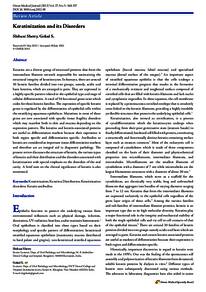Document
Keratinization and its disorders.
Identifier
DOI 10. 5001/omj.2012.90
Contributors
Gokul, S., Author
Publisher
Oman Medical Specialty Board.
Gregorian
2012-09
Language
English
English abstract
Keratins are a diverse group of structural proteins that form thei ntermediate filament network responsible for maintaining the structural integrity of keratinocytes. In humans, there are around 30 keratin families divided into two groups, namely, acidic and basic keratins, which are arranged in pairs. They are expressed in a highly specific pattern related to the epithelial type and stage of cellular differentiation. A total of 54 functional genes exist which codes for these keratin families. The expression of specific keratin genes is regulated by the differentiation of epithelial cells within the stratifying squamous epithelium. Mutations in most of these genes are now associated with specific tissue fragility disorders which may manifest both in skin and mucosa depending on the expression pattern. The keratins and keratin-associated proteins are useful as differentiation markers because their expression is both region specific and differentiation specific. Antibodies to keratin are considered as important tissue differentiation markers and therefore are an integral aid in diagnostic pathology. The present review discusses the structure of keratin, the various types of keratin and their distribution and the disorders associated with keratinization with special emphasis on the disorders of the oralcavity. A brief note on the clinical significance of keratin is also mentioned.
Member of
Resource URL
Citation
Shetty, Shibani, & Gokul, S. (2012). Keratinization and its disorders. Oman Medical Journal, 27 (5), 348-357.
Category
Journal articles

